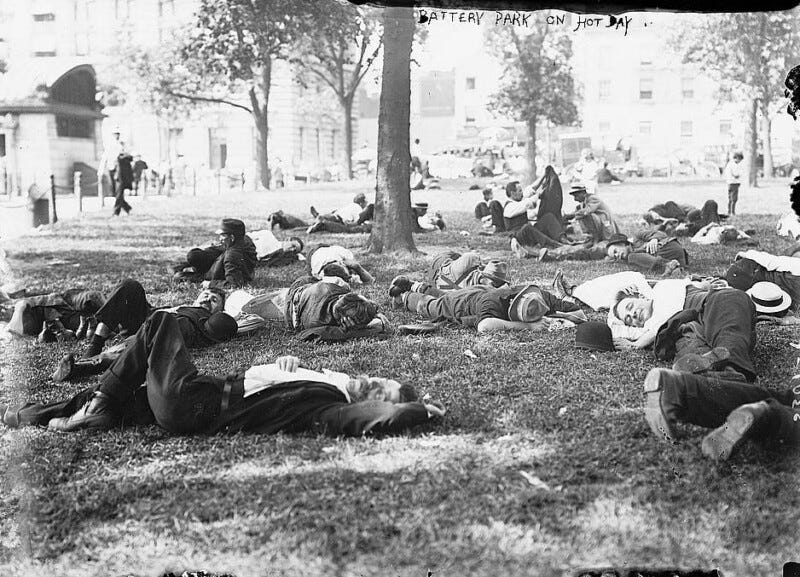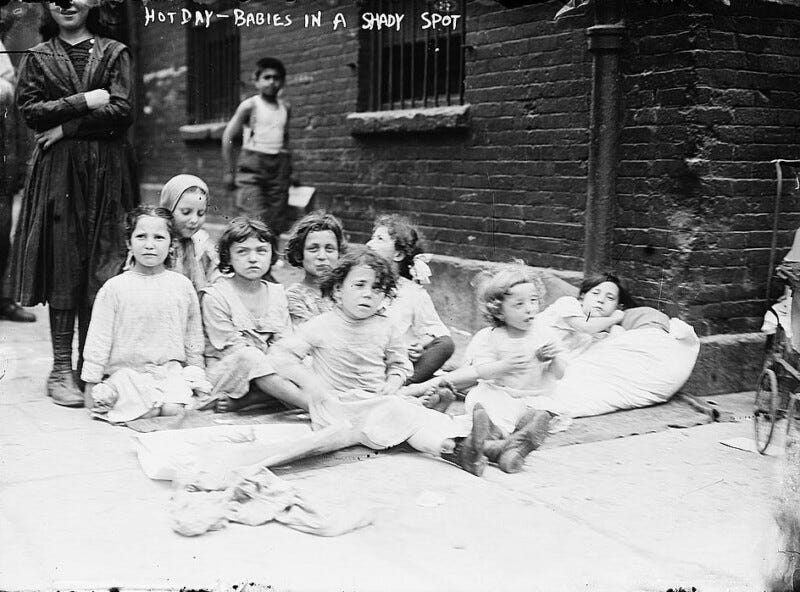I have been feeling a lot of climate grief lately. New Mexico has been hot and dry this summer, after a hot and dry and very windy spring. We’ve had July temperatures in May. The desiccating winds have continued into June. Our rivers are low or dried up completely because we didn’t get enough snow pack over the winter to sustain them. Piñon trees are dying. The sky has been heavy with smoke from wildfires.
New York City hit 100 degrees yesterday, and The New York Times published an article called 27 No-Cook Recipes for a Heat Wave. In my summer melancholy, the tone struck me as a bit off-key. Are we meant to ignore the climate and delight in the flavors of a sweaty meal?
But I also learned a new word this week: sanguine.
adjective
optimistic or positive, especially in an apparently bad or difficult situation.
Perhaps it is best to stay cheerful despite the news. Perhaps we should smile through out bites of salad?
Heat domes are not new. In fact, in 1911, a deadly heatwave hit the Northeastern United States. New York experienced temperatures reaching 100º F. The asphalt streets melted. Horses, the main form of transportation at the time, collapsed from heatstroke.
Of course, the poor suffered the most, as tenement buildings had little ventilation and became suffocating. The evenings barely cooled off, so sleeping inside became intolerable, and people fled to the city parks. In Massachusetts, nearly 5,000 people spent the nights in Boston Common. When ice—essential to preserving food—ran dangerously low, it was the economically disadvantaged that went without.
The heatwave of 1911 lasted 12 days and killed around 2,000 people.
According to research, heat waves now occur three times as often as they did in the 1960s, and climate change is making heat domes 150 times more likely because warming in the Arctic alters the jet stream.
So how should we respond? Should we sit down and celebrate the summer flavors of a chilled white bean caprese and a cucumber avocado salad on a day when the thermometer reaches triple digits? Should we mourn the loss of past climates and ecologies, or try to adapt and embrace the global weirding? How can we relish in a hot day despite what it might portend for the future? How should we be feeding ourselves today for a more equitable and livable future?
It’s raining heavily now, and has been for hours. The moisture is welcomed, of course, as is the cooler temps, but the intense delivery feels a bit disconcerting. I don’t remember monsoon season being like this when I was a kid. Usually the rain would just come down heavy for half an hour or so, and then clear away, the sky sparkling blue, the land refreshed, a glorious rainbow, or two. And these summer rains were consistent, appearing every afternoon.
Now the summer rain comes unpredictably, often violently, hanging around for hours and sometimes days at a time, then disappearing for weeks, like a bad lover. I wonder if New Mexico will become a humid hot tropical paradise in the future. I wonder what summer will be like 100 years from now? Hopefully, there will still be rainbows.
And we will all be sanguine babies, in a shady spot, eating salads.
You can find this week’s writing prompts below!
If you would like access to these food writing prompts, or to support Feed Me Figs in general, you can upgrade to a paid subscription here.
If you do not wish to subscribe yearly, you can pay for a month at a time for the low price of an oat milk Matcha latte with lavender honey.
If you’ve been wanting to support my work but haven’t yet, now is a great time to do so. Being an artist in this world is often financially precarious, and my work relies on the support of many. I could not do this without you. You are my modern-day patrons, $8 at a time, and I am so grateful for the support.
Also, no one will be turned away for lack of funds. If you think you would benefit from a paid subscription but can’t afford one at this time, email me at ginarae@substack.com, and I will gift you one.
Here are this week’s writing prompts.
Keep reading with a 7-day free trial
Subscribe to Feed Me Figs to keep reading this post and get 7 days of free access to the full post archives.








